
Author: G. DIETERLEa and A. KARSENTYb
a:Executive Director, International Tropical Timber Organization (ITTO), Yokohama, Japan
b:Senior Researcher, at the French Agricultural Research Center for International Development (CIRAD), Montpellier, France
SUMMARY
Tropical forest degradation is a major source of greenhouse-gas emissions, but international forest and climate policies are yet to respond decisively to this. In some regions, as a result of population growth, climate change and forest degradation, the increased need for wood, whether for timber or fuelwood, will exceed the sustainable supply capacity of natural forests and plantations, potentially accelerating deforestation processes. As with the issue of food security, a problem of “wood supply security” is emerging in several developing countries. This issue is poorly understood by most international initiatives focused on climate or biodiversity, which want to conserve forests but neglect the importance of the productive role of forests to support this conservation through their sustainable use. Solutions exist, but a number of barriers, starting with unclear tenure rights and short-sighted policy choices, prevent the large-scale deployment of these ones. Putting investment back at the forefront of the international agenda and setting the right incentives for producers is necessary to overcome these barriers and create the conditions for achieving future results sought by the “results-based payments” schemes such as REDD+, currently favoured by donors. Beyond the production side, the role of the global demand and the consumers is critical, and trade policies should evolve significantly to favour sustainable and deforestation-free productions.
INTRODUCTION
Several major international initiatives have emerged over the past thirty years to try to curb eforestation and degradation of forests. The fight against deforestation dates back to the mid-1980s with the launch of the Tropical Forest Action Plan (TFAP) on the joint initiative of FAO, UNDP, the World Bank and WRI, and its national variations in the form of programming exercises and project “shopping lists”. Many other initiatives, multilateral or bilateral, public or private, have emerged since then. The UNFF, established in 2000, is the last avatar of a couple of multilateral initiatives aiming at implementing the Forest Principles associated with the Agenda 21 adopted at the UN conference in 1992 and with the ambition to prepare an international Forest Convention. The diverging views among countries on the desirable use of forests and the reluctance of some developing countries to any international law that could reduce their right on their natural resource, ruined this ambition (Lipschutz 2000). Forests issues has been addressed by other international agreements, the “climate dimension” within the UNFCC, the biodiversity ones within the CBD and the timber trade through the International Timber Trade Agreement (2006). It resulted into a fragmented international regime (Humphreys 2009), likely to remain as such given the tension between forests as resources reserve – under sovereignty of States and various property rights of land users – and forests as ecosystem services provider – services that can be considered as global public goods (Karsenty and Pirard 2007).
Forest certification has been launched by civil society organizations and private actors in the 1990’s. FLEGT initiative, designed to eliminate illegal timber from international trade, is a public scheme focused on bilateral agreements (the Voluntary Partnership Agreements, or VPAs). All these initiatives are sectoral, forest-centered. Since the main direct drivers of deforestation are agriculture and cattle ranching, it became necessary to broaden the perspective, from forest policies to forest-related policies (Singer 2008), all public or private policies that have impacts on forests. REDD+, as a “hands-off” results-based payment scheme for curbing emissions related to national forest cover, allows for thinking beyond the forest sector boundaries. The last initiatives in date, promotion of deforestation-free supply chains for agricultural productions focus deliberately outside the forestry sector to protect the forests.
With REDD+, the dominant idea is that the tension between forests-resources and forest-services, or, putting more conventionally, between development and forest conservation, can be overcome only by compensating developing countries for the foregone revenues of not converting their forests into other land-uses. In other words, rich countries would have to pay the “opportunity costs” of forest conservation to developing countries, as it was suggested, notably by the Stern Review (Zenghelis 2006). This “opportunity cost” framing is implicitly expressed in this economic statement of an influential REDD+ analyst: “REDD+ countries have an incentive to reduce deforestation up to the point where the marginal cost of reductions (i.e. the national supply curve of REDD) is equal to the international compensation, for example, the market price for REDD+ credits” (Angelsen 2008:59). Such a framing of the debate is, however, tricky, as it suggests an entire transfer of burden to industrialized countries through their willingness to pay and departs from the principle of “common but differentiated responsibilities” adopted in Rio 1992.
This framing through the exclusive lens of opportunity costs has been softened since the inception of REDD+ in 2005 and the influential Stern Review. It became clear that the opportunity costs of not developing industrial agriculture (oil palm, soy, rubber. . .) was high and likely to escalate with the growing demand of food and the, expected, limited access to new lands if REDD+ was to succeed. The McKinsey report (2009) was very significant on this respect: paying the opportunity cost was only affordable with food crops oriented small-scale farmers (see also Ickowicz et al. 2017). And again, the McKinsey report suggested that, given “ethical considerations”, payments to such farmers would be well beyond the (low) opportunity costs. Moreover, the opportunity cost is only one part of the story. To estimate the likely cost of REDD+, one have to factor in the cost of investments needed to, say, clarify land tenure, adoption of forest-friendly (and more productive) agricultural practices, design and monitor incentive schemes for farmers, rebuild an affective administration to implement policies, etc. (Fischer et al. 2011, Gregersen et al. 2012, Angelsen et al. 2012, Thompson et al. 2017).
If opportunity costs are too high, with respect to the price of carbon credits and/or the willingness to pay of developed countries, another way to frame the issue is to consider that payments will encourage governments already committed to protect their forests, and will serve as policy arguments for forest protectors against the forest conversion lobbies. Such a reframing of the issue emphasizes the multiple benefits of forests, as a bundle of renewable resources and as a support for ecosystem services, to orient national policy choices vis-à-vis the forests, rather than fueling expectations about financial compensations for the highly uncertain opportunity cost of not converting forests (and potential perverse incentives associated). In that respect, economic valorization of forest resources, starting with wood, should be put back into the conversation and reflections on the barriers to investment and the needed incentives for producers to engage into better practices is necessary.
This article analyzes the growing demand of wood, either for timber or energy, its consequences in terms of forest degradation, and the needed response in terms of investment for “wood security”, through more efficient practices of the forest industry and forest restoration. Investment is a necessary but not sufficient condition for change, if various barriers are not removed. Beyond the over-debated issue of public governance, the article insists on two critical policy elements needed to overcome barriers: sharing rights on forest resources and design appropriate incentives. Finally, the article take stock of the promising initiatives aiming at promoting deforestation-free supply chains for timber and agricultural products, and propose the use of modulated custom tariffs to provide a commercial advantage to certified deforestationfree products.
TROPICAL FOREST DEGRADATION HAS BEEN UNDERESTIMATED
The latest research suggests that forest degradation is at least as big a problem for carbon dioxide (CO2) emissions as actual deforestation. As shown in Figure 1, forest degradation is advancing rapidly, especially in the peripheries of the big tropical forests (e.g. the Amazon, the Congo Basin and Borneo) and in drier areas where people must satisfy their daily needs for wood and non-wood products (e.g. southern and western Africa). Forest degradation is estimated to account for 50–70% of CO2 emissions in the tropics (depending on the method of calculation) (Erb et al. 2018). Yet international forest policy is not yet paying sufficient attention to degradation and its impacts on human communities and the natural environment. It is rapidly becoming evident that the take-up of agricultural land cannot be blamed as the sole driver of forest-related emissions and that consideration must also be given to other important factors, such as daily demand for woodfuel and timber among local communities, a lack of expertise in forestry management, a failure to invest, illegal practices, and reduced forest vitality due to climate change. Forestry agencies and forest-related institutions could address at least some of these factors.
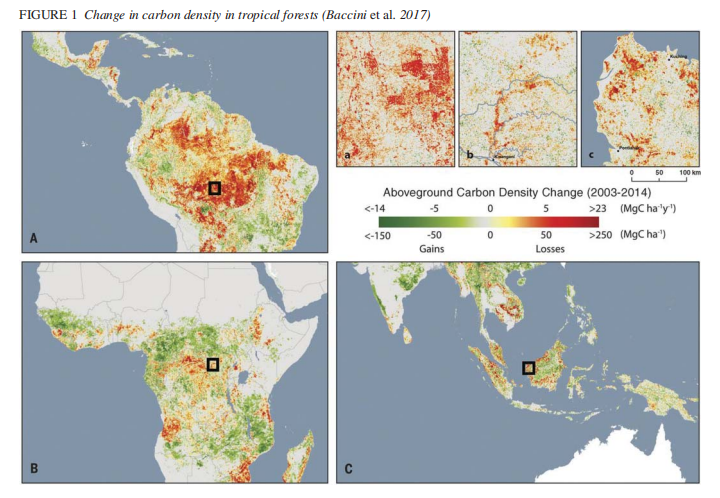
POPULATION GROWTH BOOSTS DEMAND FOR WOOD
The lower productivity of tropical forests due to climate change will coincide with an expected dramatic increase in demand for wood products and wood energy in coming decades, especially in Africa. This additional demand will increase at least as fast as demand for food. We should be talking not only about food security but also about what we can call in mirror, “wood security” because wood products and wood energy are just as essential as daily nutrition and clean water for satisfying people’s basic needs.
The forecasts are extremely worrying: on the one hand, the global population will grow rapidly and, on the other, forestry stocks will dwindle swiftly. The annual supply gap for wood is projected to rise to as high as 6 billion m3 by 2050. Analyses by the World Bank, including case studies in selected tropical countries (Figure 2), indicate that this supply gap will affect large swathes of the tropical regions by the middle of the century (World Bank 2017).
WOOD’S ROLE IN A SUSTAINABLE BIOECONOMY
One reason why this trend is so worrying is that, as a consequence, the use of sustainably grown wood as a substitute for non-renewable materials and energy will be unable to play its full role in countering global warming. This role could be considerable, as shown by an analysis by the German government and recent studies by the World Bank and by Yale University (De Galbert, Dieterle et al. 2013, Oliver et al. 2014) (see also Figure 3): the substitution effects of using more wood products (in construction and furniture, etc.) are greater than using forests as a carbon sink alone, especially given the growing vulnerability of these sinks in the context of global warming, with extreme events such as hurricanes and “mega fires”.
After many years where harvested wood products (HWP) were treated as emissions, the IPCC, in particular in the latest Special Report (IPCC Special Report on Climate Change, Desertification, Land Degradation, Sustainable Land Management, Food Security, and Greenhouse gas fluxes in Terrestrial Ecosystems 2019), and also UNFCCC finally recognise the important mitigation role they play as part of a bio-based and circular economy.
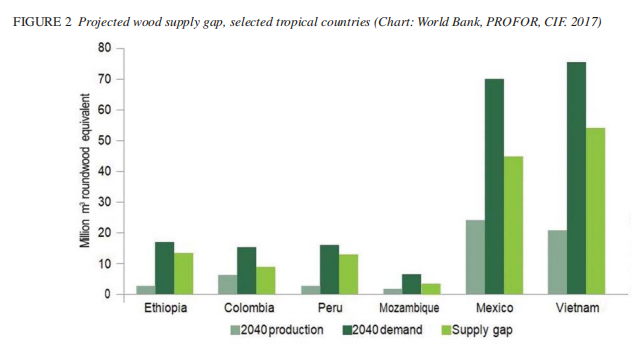
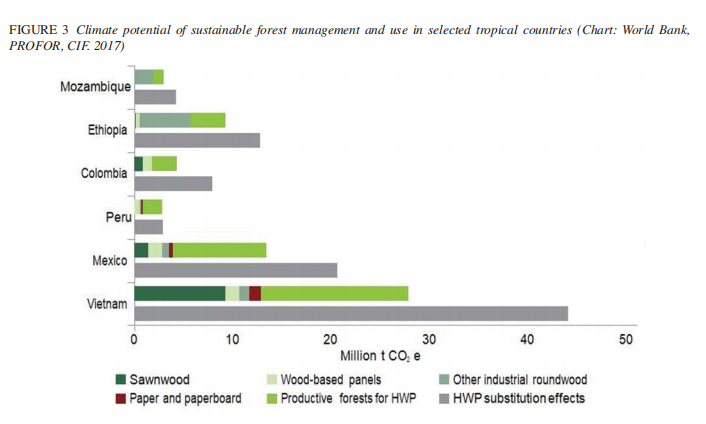
SAVING TROPICAL FORESTS THROUGH INVESTMENT AND INCENTIVES
There is an urgent need for more analysis because the conclusion is clear: forest protection measures alone will be insufficient to save key tropical forests. Rather, sustainable-use strategies, incentives and investments will be necessary to satisfy the predicted additional demand. A failure to act would be irresponsible, and it would have adverse consequences for sustainable development in many tropical countries due to:
• the greater use of non-renewable resources, especially in connection with rapid urbanisation in the tropics;
• the rising pace of forest degradation to satisfy daily needs for wood and wood energy;
• the pressure to fill supply gaps with imports from temperate countries running wood surpluses; and
• the loss of jobs and income, especially in rural regions, combined with a faster pace of migration.
As it is, countries producing tropical wood already face tangible disadvantages. For one thing, tropical wood suffers from a poor image and is associated with deforestation, degradation and corruption. As a result, tropical wood producers attempting to produce sustainable timber experience considerable disadvantages and risks (Table 1).
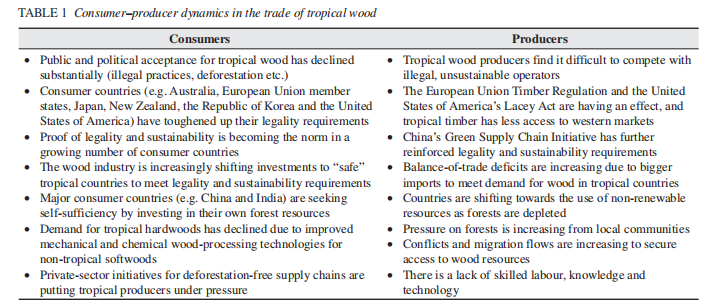
Landscape restoration founded on sustainable added value
What is urgently needed, therefore, is massive investment in:
• forestlands rights’ and tenure clarification;
• forest landscape restoration and reforestation
• the efficient management of existing forests and reducing losses from unsustainable harvesting practices; and
• better protection of high-conservation-value forests.
Forest restoration and reforestation are of utmost importance. Tree plantations are necessary to feed the growing demand of fuelwood and timber the natural forest would not be in capacity to supply. However, tree plantations are often oriented towards softwoods for pulp and paper production or fast-growing species in monocultures that often replace degraded natural forests when land-use planning is not designed or enforced (Kröger 2014). In Indonesia, the pulp sector continues to rely on natural forests for timber rather than using idle lands (Obidzinski and Dermawan 2012) and comparable situation took place with pine plantations in Chile (Nahuelhual et al. 2012). And when, in addition, tree plantation management is inadequate, the ecological impact of such plantations may prove disastrous for soils (acidification) and underground water reserves, along with biodiversity impoverishment (Jackson et al. 2015).
A big challenge in this new era is to provide forest owners with the right incentives for developing long-lived multispecies plantations and uneven-aged high stand harvests. Longterm tenure security is key, but financial incentives such as tax or fee rebates, subsidised loans and/or payments for results, as well as support for capacity building and skill development, including for certification, would be needed to counter the preference for short term of many forest owners. In places where population density is increasing rapidly, most future trees will be grown in agroforestry systems, which may or may not include timber trees. Here, too, incentives are needed to encourage timber production in sustainable agroforestry systems. Guaranteeing tree tenure to the people who planted them would be a first-order incentive (for a long time in Côte d’Ivoire, for example, timber trees were state property and allocated to loggers, leading farmers to remove them from their fields). Financial incentives and “future” contracts with industrial buyers for guaranteeing profitable outlets are policy options worthy of consideration.
Traditional reforestation is generally expensive (USD 1500 per ha or more) and, especially in semi-arid areas, the survival rate of planted trees is often low. In the Sahel, tree survival rates in reforestation initiatives was around 20% in the 1970s (Wade et al. 2019). The high mortality was due principally to low rainfall, but additional factors, such as planting shock and termites, contributed to these disappointing results.
An alternative is natural regeneration, whether assisted or not (assisted natural regeneration involves tending the seedlings and young shoots that establish naturally in an area). In addition to a lower overall cost, natural regeneration promotes local genetic and functional diversity. The plant and animal species that return and establish are adapted to the site, promoting ecological interactions. In this way, naturally regenerated forests contribute to connectivity, biodiversity conservation and resilience. In Niger, for example, there is a dynamic of local-farmer reforestation on fallows, encouraged by the collective organisation of villages. The costs of projects to support assisted natural regeneration are significantly lower than for traditional afforestation on dedicated land (the World Resources Institute indicates an average cost of USD 20 per ha in Niger; Reij and Winterbottom 2017). In many developing countries, the main difficulty comes where land rights are uncertain and leaving land to a process of natural regeneration can be interpreted as a sign of legal vacancy – potentially enabling squatter invasions. It must also be possible to protect regenerating areas from livestock, requiring local collective action for landscape management. If the issues of land tenure and collective action can be addressed, we agree with Wade et al. (2018) that natural regeneration is a viable, cost-effective alternative to tree planting if increasing biomass production is the desired outcome.
Sharing rights on forestlands
Selective harvesting in the tropics allows the multiple use of forestlands and represents a compromise between productive use and maintaining biodiversity. However, the transition from specialised land use (i.e. land sparing) to the sustainable management of several resources and overlapping use rights on a given piece of land (i.e. land sharing) is a big challenge in the tropics. Traditional forest concessions involve the allocation of commercial rights to timber only, thus excluding other resources – which sometimes are allocated to other economic operators. Combining the sustainable commercial use of several resources (e.g. non-timber forest products, genetic resources and trophy hunting) on the same concession area and developing agroforestry in degraded or non-forested areas of concessions can create more financial value per unit area. It would only be socially acceptable, however, if the benefit is shared equitably with local communities who claim customary tenure rights within concession areas (Karsenty and Vermeulen 2017).
Participatory mapping of all the areas of customary tenure, whether or not they overlap with forest concessions or protected areas, is a first step in the political recognition of local tenure rights. Having multiple “layers” of tenure rights is not only a characteristic of customary tenure regimes (where rights to trees may differ from rights to land, for instance), it is also a promising way to address the increasing claims of various resource users invoking different sources of legitimacy to support their claims. Some certified concessionaires in Gabon have made significant steps toward a more equitable sharing of timber revenues through participatory mapping exercises on the entire forest concession. Public regulation has institutionalized such timber revenue sharing directly inspirited by the experience of a pioneer concessionaire (Karsenty and Vermeulen 2017).
The recognition of such rights is also a first step towards the inclusive governance of forest concessions, including area-explicit criteria for benefit sharing. It might be a promising avenue for building new relationships between the industry and local communities and a new paradigm for multi-resource development in natural landscapes.
Efficient management practices
Another undervalued option for restoring landscapes or limiting forest landscape degradation is the wider adoption of management practices oriented towards the efficient use of resources in forests managed for timber, wood-based energy and non-timber forest products. For example, a recent study by Ellis et al. (2019) on the potential of reduced-impact logging (RIL) to reduce carbon emissions showed impressive results, especially when harvest intensity is significant. It found that the full adoption of well-known RIL practices would reduce logging emissions by 44% (equivalent to 366 million tonnes of CO2) and deliver 4% of the nationally determined contributions to the Paris Agreement on climate change in tropical countries while maintaining timber supplies. Achieving these outcomes requires careful planning of skid trails to reduce collateral damage; training on directional felling along narrow hauling roads; and a shift to low-impact skidding equipment.
Ellis et al. (2019) propose incentivising logging operators and companies to adopt these practices. An obstacle to adoption is the common practice of subcontracting logging, sometimes with perverse incentives embodied in contract agreements (e.g. payments based on volumes supplied, without regard to work quality). Public regulations generally do not address this issue, but forest management certification does. This is another reason to consider positively the use of forest management certification in public policies.
The current global push towards forest and landscape restoration is in the right direction, but the focus is still mostly on outcomes for climate and the environment, and there is insufficient attention on ensuring commercial and cost viability and the creation of employment and income.
There is a need, therefore, to “beef up” international forest and climate policy if the forest-related Sustainable Development Goals are to be achieved by 2030. The measures envisaged under REDD+ must be updated to include massive incentives and appropriate conditions to promote sustainable investments by private entities and local authorities (Table 2), as well as ensuring just forest rights; providing more support for vocational training and technical knowledge; and taking action to counter corruption and illegal logging. In many countries, sustainable forest management (SFM) is still considerably more expensive than unsustainable practices and therefore cannot compete with business-as-usual approaches.
Economic and social incentives for sustainability and inclusive governance
As paradoxical as it may seem, tropical forests can be conserved through sustainable use and the responsible consumption of forest products. Indeed, a large reason for the existing high rates of deforestation and degradation has been the lack of competitiveness of SFM. If we consider forest management certification as a proxy for SFM, studies suggest that it brings net potential gains. A 2015 WWF study estimated that it cost almost USD 5 per m3 to prepare companies for certification (including the cost of the audit itself) in a natural tropical forest and another USD 3.5 per m3 per year to maintain the certification. The same study assessed the annual financial benefits at around USD 6.03 per m3 of roundwood equivalent production, outstripping average annual costs and estimated opportunity costs. Operators in the tropics show the largest annual net benefits.
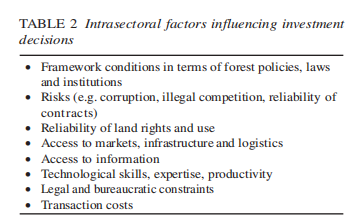
These financial benefits, however, rely partly on achieving a price premium for certified timber, but not all markets offer such a premium. Where it does exist, it is, on average, around 5–10% of the FOB price (Oreade Brèche-PPECF 2017), although it can be higher for some species and markets (e.g. hardwoods in northern Europe). Actually, a significant part of the timber from certified concessions is sold without mentioning certification in local markets or when exported to emerging markets (except when the importer, such as a wood processor in China, intends to re-export the finished product to Western Europe or North America). It means that even a high price premium might not represent a sufficient incentive for remaining certified if it applies only to a small portion of production.
International financing institutions have been hesitant to tackle the issue of macro-economic incentives and financial instruments in natural resource use, even though creating a level playing field would be more cost-efficient and effective than complex compensation payments to governments. Well-established, practical instruments such as the certification of SFM and tracking technologies for deforestationfree supply chains are already available for verifying legality and sustainability. Donor organisations could expand their toolsets to enable the implementation of verifiable incentive mechanisms aimed at encouraging the sustainable use of natural resources in the tropics. With domestic and emerging-country markets for tropical timber increasing their share of the tropical timber trade, the price premium “bet” is losing ground. If sustainable timber prices are not high enough to bring about massive changes in management practices, governments and donors must think about alleviating the costs of sustainably produced timber. Subsidies have been used in the Borneo Initiative since 2011. This project, funded by Dutch companies and government, contributes two dollars per hectare to FSC-certified companies (Bartley 2014). This is likely to have contributed to the figure of 3 million hectares FSC certified in Indonesia in 2018, of which 2.8 million are production natural forests. However, international public donors are generally reluctant about direct subsidies to logging companies, when they do not have internal policies prohibiting them.
An important lever, among others, for creating a level playing field for economic operators who otherwise cannot compete against unsustainable business-as-usual practices is the use of taxation or other financial incentives such as subsidised and guaranteed loans or specific grants. Reducing forest taxes or providing other tangible benefits for those timber producers who implement responsible forest management practices might be a way to incentivise even those who cannot expect a price premium in their markets (Karsenty 2019).
Forest management certification might be used by governments to target those who will benefit from fiscal or other financial advantages. Donors could conclude bilateral agreements with national governments about budgetary support for compensating foregone fiscal revenues, complementing payments for results under REDD+ phase 3. Figure 5 provides a diagrammatic example of how such a scheme could work.
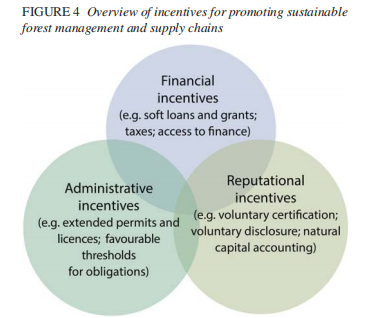
In many tropical countries, an important obstacle to the implementation of incentive mechanisms on the ground is the limited physical and human capacity – especially in small and medium-sized enterprises – for building or participating in legal and sustainable supply chains from the forest to the market. This includes a lack of capacity in landscape-oriented forest management planning; efficient and environmentally friendly production; tracking, verification and documentation tools; and access to responsible business partners. It is imperative, therefore, that incentive mechanisms are underpinned by technical assistance, training and capacity building for those economic actors committed to making a change.
Even a well-designed incentive scheme will be useless, however, if producing countries do not engage firmly against illegal logging, which not only undermines the rule of law but also makes legal and sustainable timber production uncompetitive. In this respect, the efforts of the European Union (EU) to tackle illegal timber imports through both the 2013 EU Timber Regulation (which criminalises the importation of illegal timber into EU countries) and voluntary partnership agreements (VPAs) between the EU and several tropical timber producing countries can be considered an important step in the right direction. Applied alone, however, VPAs do not seem sufficient to level the playing field between the most committed forest operators and business-as-usual practitioners (Carodenuto and Cerutti 2014, Hansen et al. 2018, Rutt et al. 2018). Combining fiscal incentives for SFM andsustained policies to reduce illegal logging might be a promising avenue.
CONTAINING FOREST LOSSES THROUGH TRADE IN LEGAL AND DEFORESTATION-FREE SUPPLY CHAINS
We can derive some optimism from the willingness now being shown in the private sector and international trade to set up legal and sustainable deforestation-free supply chains for food and wood products. Consumer countries have a major responsibility for encouraging sustainability among tropical wood producers. The EU Timber Regulation appears to be having an impact, even if it is implemented unevenly by member states. According to a study by WWF UK, there has been a sharp fall in recent years in the percentage of potentially illegal wood and wood products, with current estimates putting it at 15%. China, Europe’s biggest trading partner for wood products and the world’s largest importer of tropical wood (Figure 6), has adopted the national Green Supply Chains Strategy as part of its new “ecological civilisation” philosophy, not least because of louder demands from various sales markets. In early 2020, China issued a fist draft of a new forest law that adds a prohibition on buying illegally sourced timber. The current version doesn’t go far enough to establish a legal framework for requiring supply chain due diligence to prevent purchasing, trading, or importing illegal sourced timber, but this firt move of the largest timber buyer’s country is full of promises.
In June 2018, twelve corporate industry leaders with an estimated combined trading volume of USD 14 billion joined, with support from ITTO (Dieterle 2018), to form the Global Green Supply Chain initiative (GGSC). Later, in October 2019, ITTO in partnership with industry associations and private-sector partners convened an international forum in Shanghai, China (ITTO 2020). There, more than 200 private sector companies, including 34 large timber-purchasing companies from different regions of the world agreed to expand this voluntary network to promote recognition of the economic, social and environmental values of forests and the incorporation of legality and sustainability in all forestry operations. The GGSC network is open to all interested parties worldwide and is expected that it has high potential to change the forest industry’s image and will become a motor for promoting sustainability of tropical forest management.
Economic incentives for deforestation-free agricultural commodities
Policies aiming at halting deforestation solely through freedeforestation supply chains face a couple of difficulties, however. One is the limited capacity of companies to trace products back to individual producers and land parcels when the production is spread among myriad small-scale farmers. This difficulty is evident in similar efforts to trace cocoa and natural rubber to their smallholder origins, often in situations where land registers are almost non-existent. In Côte d’Ivoire and Ghana, for example, both of which are major cocoa producers, identifying the producer and the corresponding plot is sometimes very difficult. Companies generally can track production to the level of cooperatives, which often collect their cocoa beans from mixed sources. Unclear land tenure makes full traceability challenging.

A second difficulty lies in the fact that deforestation is not always attributable to a single driver or a single commodity chain controlled by committed companies. Charcoal, food crops for local consumption, and urbanisation are also major drivers of deforestation and degradation. It is necessary, therefore, to combine deforestation-free supply chains and landscape/territorial policies to address other drivers (Biénabé et al. 2017). Land-use planning and establishing legal status for land uses is certainly the most necessary policy tool, but incentives are also needed to change individual and collective land-use practices to help people choose conservation, agroforestry and forest restoration rather than conversion to monocultures. Countries such as Costa Rica have shown the potential of national payment schemes for environmental services (PES) funded mainly by domestic resources (74% of the budget) through earmarked fees on fuel (around USD 11.6 million per year) and water distribution (around USD 3.6 million per year) (Porras et al. 2018). Even the poorest countries have the capacity to levy small fees on large basis consumption practices (e.g. on phone units, beverages, and access to social networks), thereby showing political will to protect trees and forests from land conversion (Karsenty 2015). In such cases, the international community of donors is likely to provide complementary funding – as in Costa Rica, where donors provided around 40% of the annual budget of the PES programme in its early stages (Porras et al. 2018). One could expect international transfers to cover a larger share of the budget gap in least-developed countries.

The international trade should not be overlooked. Today, sustainable and unsustainable (e.g. those for which production entailed deforestation) commodities attract the same taxes or duties (i.e. export taxes and import tariffs). The World Trade Organization (WTO) principle of non-discrimination applies to “similar products”, without taking into account the production process and method (PPM) when it is “nonproduct-related” (i.e. where the production methods leave no trace in the final product, even though the method used harms the global environment). Adopting commercial measures such as lower tariffs for deforestation-free commodities and higher tariffs for the others (a principle called “feebates”, for fees and rebates) might prove difficult under current WTO rules. Negotiating the evolution of WTO rules about nonproduct-related PPM should be a priority for changing the relative prices of deforestation-free imported commodities and others. Product certifications are gradually evolving to take into account the zero-deforestation principle, using the high carbon stock (HCS) criterion proposed by several organisations. For example, the Round Table for Sustainable Palm Oil’s certification scheme for palm oil has applied the zero-deforestation principle since 2018 and considers the HCS criterion in its new certificates. Other product certification schemes (e.g. for cocoa and soy) are likely to follow suit and adopt the HCS criterion to implement the zerodeforestation principle. The use of feebates in tariffs would surely consolidate this move (Heine et al. 2017).
It is crucial that tropical food and wood producers, importers, processors and consumers work closely together because deforestation-free supply chains require intricate dovetailing and the documented tracking of products, from the field or the forest to the shop. For many tropical agriculture and wood businesses, this will be a major challenge.
CONCLUSION
In some tropical regions, as a result of population growth, climate change and forest degradation, the increased need for wood, whether for timber or fuelwood, will exceed the sustainable supply capacity of natural forests and plantations, potentially accelerating deforestation processes. As with the issue of food security, a problem of “wood supply security” is emerging in several developing countries, even if on a global scale there is no shortage of wood in sight.
This issue is poorly understood by most international initiatives focused on climate or biodiversity, which want to conserve forests but neglect the importance of the productive role of forests to support this conservation through the sustainable use of various resources, starting with wood. Solutions exist to exploit without destroying, to increase wood resources and their mobilization without harming biodiversity, to increase the added value associated with sustainable management operations in production forests, to verify the legality and sustainability of wood marketed through traceability systems...
A number of barriers prevent the large-scale deployment of these solutions. Many are institutional and reflect a lack of technical and organizational capacity in developing countries, both in government and in enterprises, especially SMEs. And sometimes it is primarily a lack of political will to combat illegal logging in order to level the playing field and make profitable the investment in SFM.
The international forest regime has evolved from initial technical forestry expertise perspective to environmental economics considerations. This broadening of perspectives is welcome, but its main policy outcome has focused more on the principle of compensation (the opportunity cost of conserving forests) than on the investment needed for incentives (envisaged notably in “results-based payments” mechanisms such as REDD+) to really work. Putting investment back at the forefront of the international agenda is necessary to create the conditions for achieving future results. Investment also means putting in place the financing instruments necessary to offer producers incentives to manage sustainably. In that respect, taxation can play a significant role, whether to collect earmarked revenues for financing incentive-oriented programmes or to promote good practices and certified production through differentiated rates.
One of the conditions for incentivizing the poorest producers and users, is the recognition and the protection of their access and use rights to the forest resources, and a more equitable sharing of the benefits of the exploitation of these resources. This is not only a matter of justice, this is also necessary so that people can obtain income from the sustainable exploitation of these resources and are not forced to operate illegally, thus making it impossible to regulate the use of these resources. Here again, instruments such as participatory mapping of customary areas exist to initiate the institutionalization of the different layers of rights over the same spaces, share the benefits of economic activities and lay the foundations for inclusive governance of concessions and protected areas. Recent legislations in tropical countries are timidly beginning to take these dimensions into account, but much remains to be done before a better balance of rights is achieved.
While the principle of the productive use of wooded resources regains some legitimacy with the development of forest certification and the FLEGT initiative, international public opinion and decision-makers have become increasingly aware that the fate of tropical forests lays out outside the forest sector, more specifically in the dynamics of agriculture and animal husbandry. Demand for deforestation-free commodities is increasing and voluntary initiatives of corporations are promising. However, there too, there are barriers related to the uncertain land tenure situation and smallholders’ lack of assets for transforming their practices while keeping their revenues. Again, investment in land tenure clarification and assets-building PES targeting smallholders will be critical for fostering changes. On the other hand, international trade policies of importing countries should evolve to promote a more responsible consumption of forest-risky commodities. Producer and consumer countries share a responsibility for conserving and expanding tropical forests. After all, their impacts on the environment, the climate and prosperity do not stop at national borders, and we all stand to benefit.

| E-mail:ggsc@itto-ggsc.org | Tel:86-10-62888626 |


Sigh Up for Emails |
|